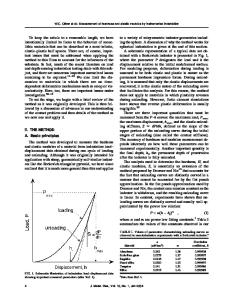The indentation hardness of silicon measured by instrumented indentation: What does it mean?
- PDF / 211,731 Bytes
- 7 Pages / 584.957 x 782.986 pts Page_size
- 49 Downloads / 402 Views
The indentation hardness of three different pure forms of silicon was investigated by two different methods. The hardness was probed by direct imaging of the residual impressions and by instrumented indentation using the Oliver–Pharr method. The forms of silicon used were a defective form of amorphous silicon, an amorphous form close to a continuous random network, and a crystalline silicon. The first form deforms via plastic flow and the latter two via phase transition. Two different unloading rates, fast and slow, were used to vary the phase transition behavior. This influenced the relative hardness as measured by instrumented indentation, which is not a reliable method to quantify hardness values in phase transforming materials. Thus, for our phase transforming silicon system, the relative hardness between samples can only be determined correctly by direct imaging, provided that the image accurately reveals the extent of the phase transformed volume. I. INTRODUCTION
Address all correspondence to this author. e-mail: [email protected] DOI: 10.1557/jmr.2012.389
deformed component surrounding the plastic zone, the plastically deformed component of the material can also recover to some extent. Such behavior clearly has to be taken into account when measuring the IH of c-Si by instrumented indentation methods since the slope of the unloading curve is used in the determination of IH. For example, measurement by the Field–Swain method12 traditionally uses fast partial unloading, yielding PI a-Si beneath the residual impression after final unloading.6,7 In contrast, the Oliver–Pharr method,13 which traditionally requires reasonably slow unloading rates for a good quality load–displacement curve, results in the formation of the crystalline phases Si-XII/Si-III. Clearly, such very different transformation pathways might be expected to influence the determination of IH since, depending on when these phases form during unloading, the slope of the unloading curve can be phase dependent. The influence of the indentation method can become even more significant when phase transforming and nonphase transforming forms of silicon are compared. For example, pure, voidless,14 ion-implanted a-Si is known to deform via plastic flow (rather than by phase transformation) due to its defective network.15,16 The plastic flow appears to be a result of material flow facilitated by the propagation of (bonding) defects or dangling bonds.15 This results in a significantly decreased IH compared to that of phase transforming c-Si.17–20 Furthermore, the IH can be critically dependent on the thermal history since ion-implanted a-Si undergoes structural relaxation upon thermal annealing.21,22 This structural relaxation is correlated to the removal of the defects present in the as-implanted (unrelaxed) state, thus resulting in a new (relaxed) state, which is as close to a continuous random network as experimentally
3066
Ó Materials Research Society 2012
The indentation hardness (IH) of crystalline silicon (c-Si) and other semiconductors has attracte
Data Loading...










